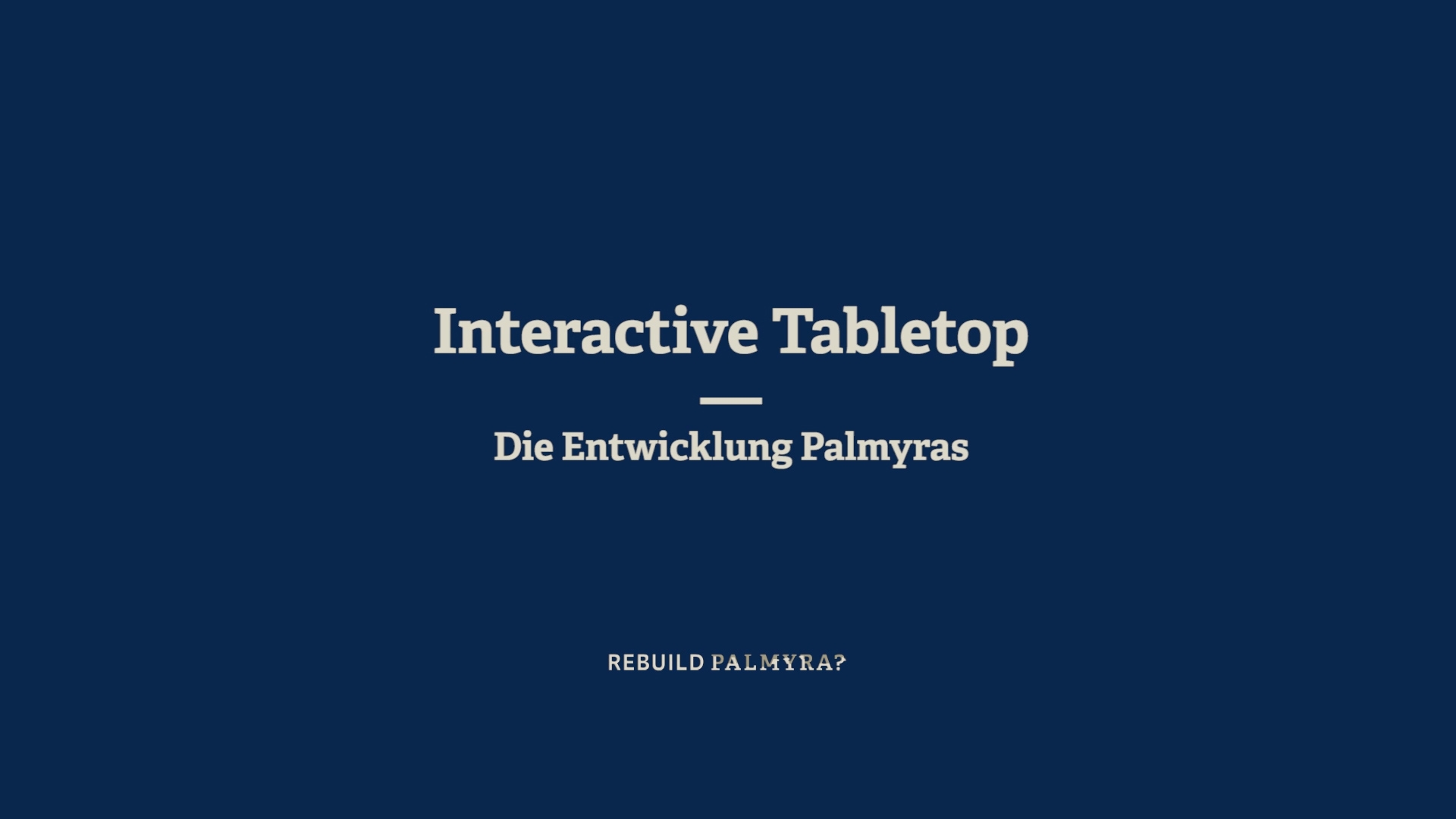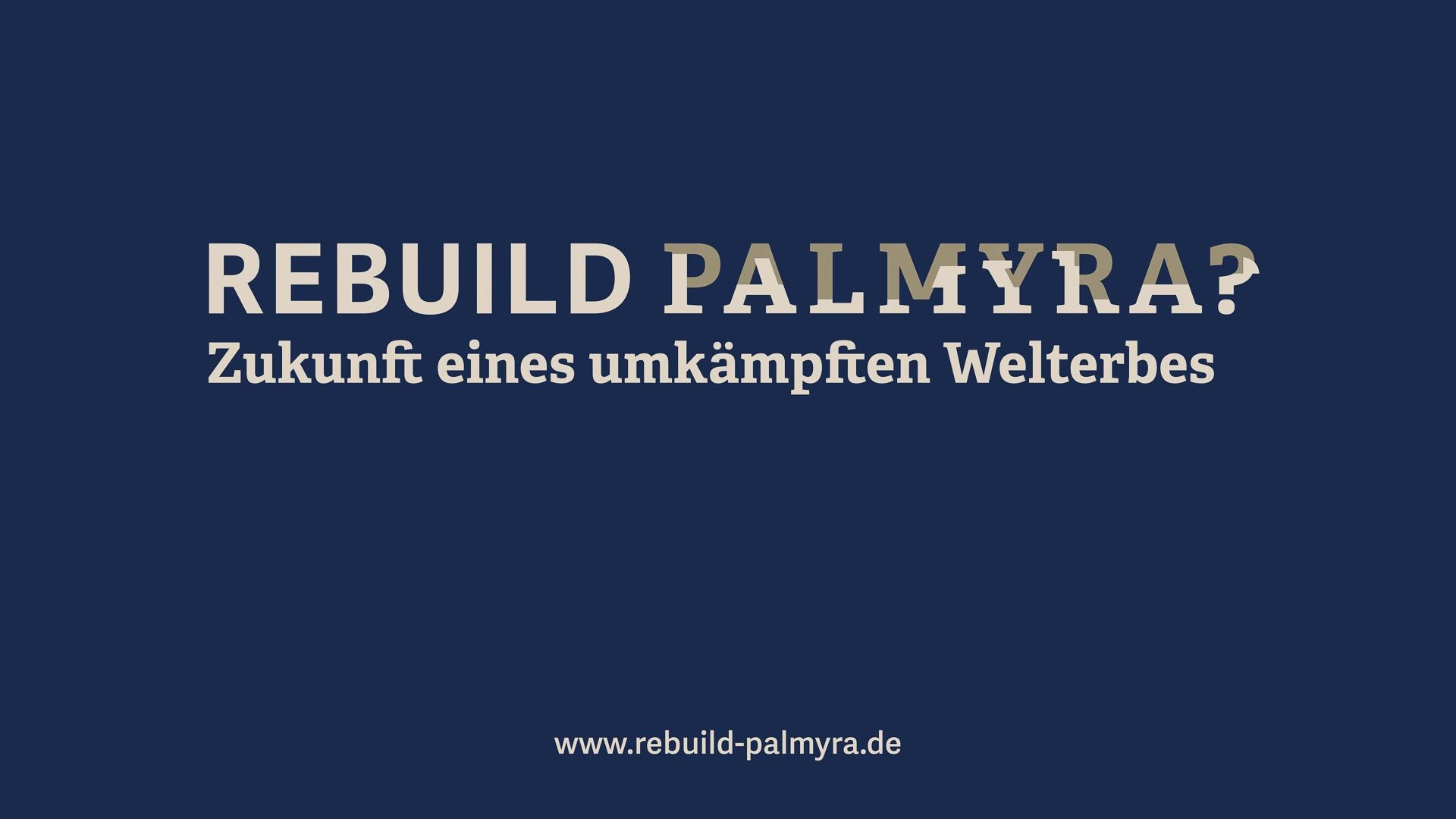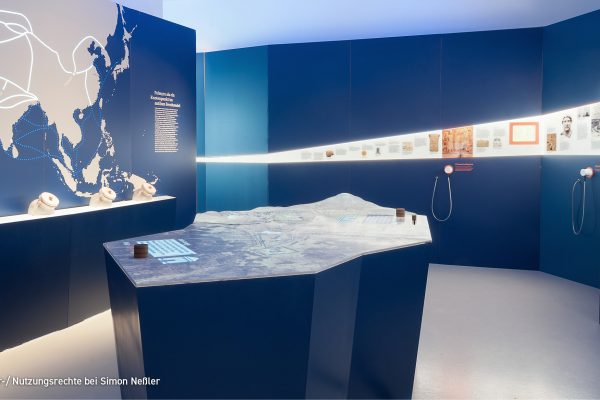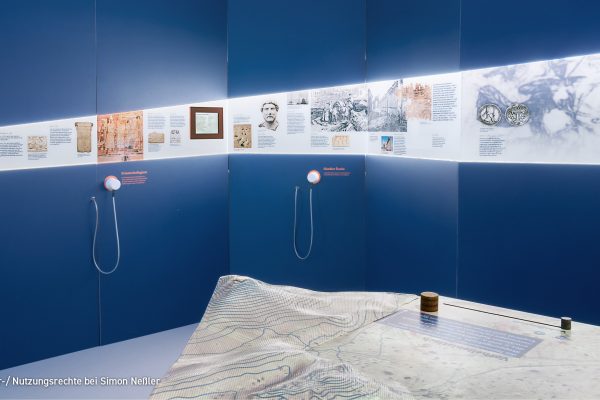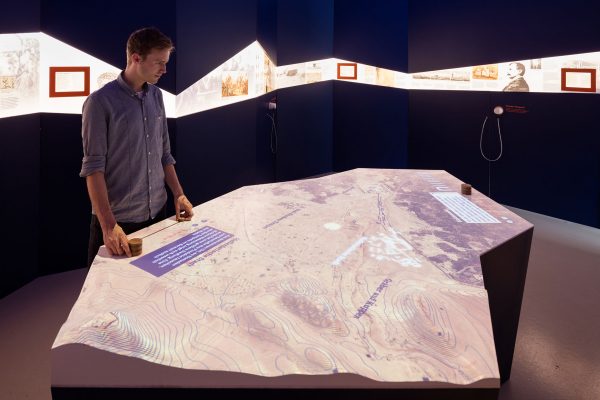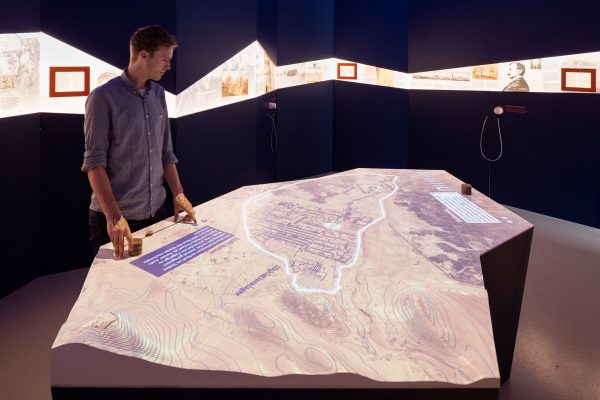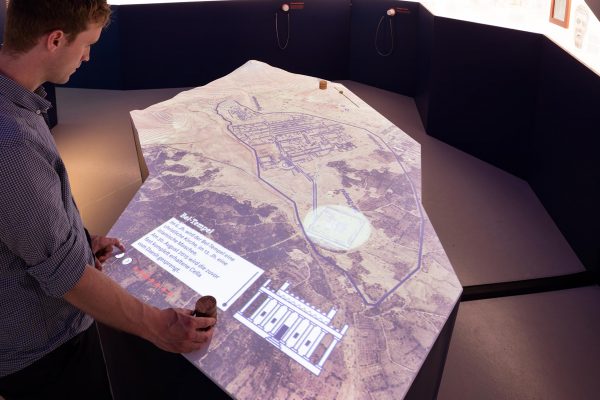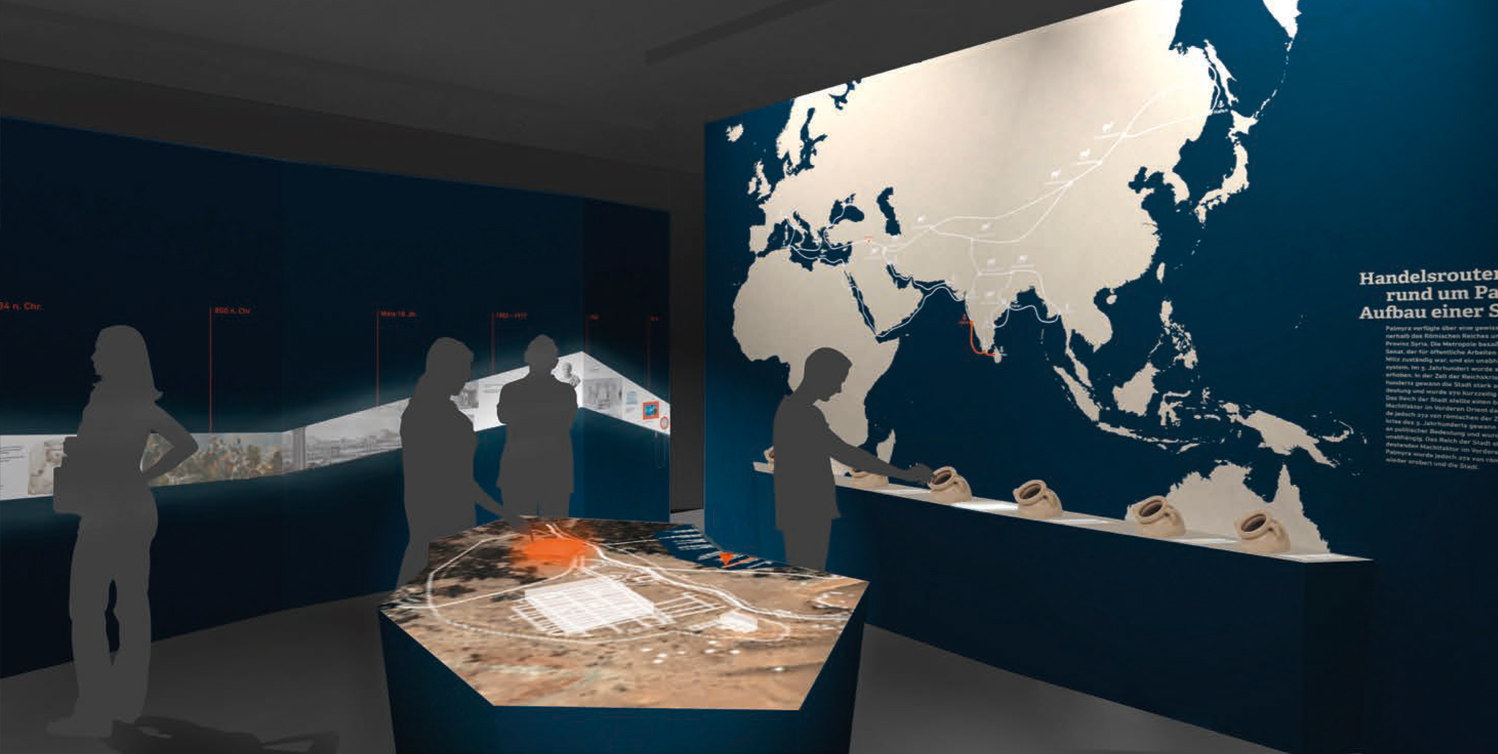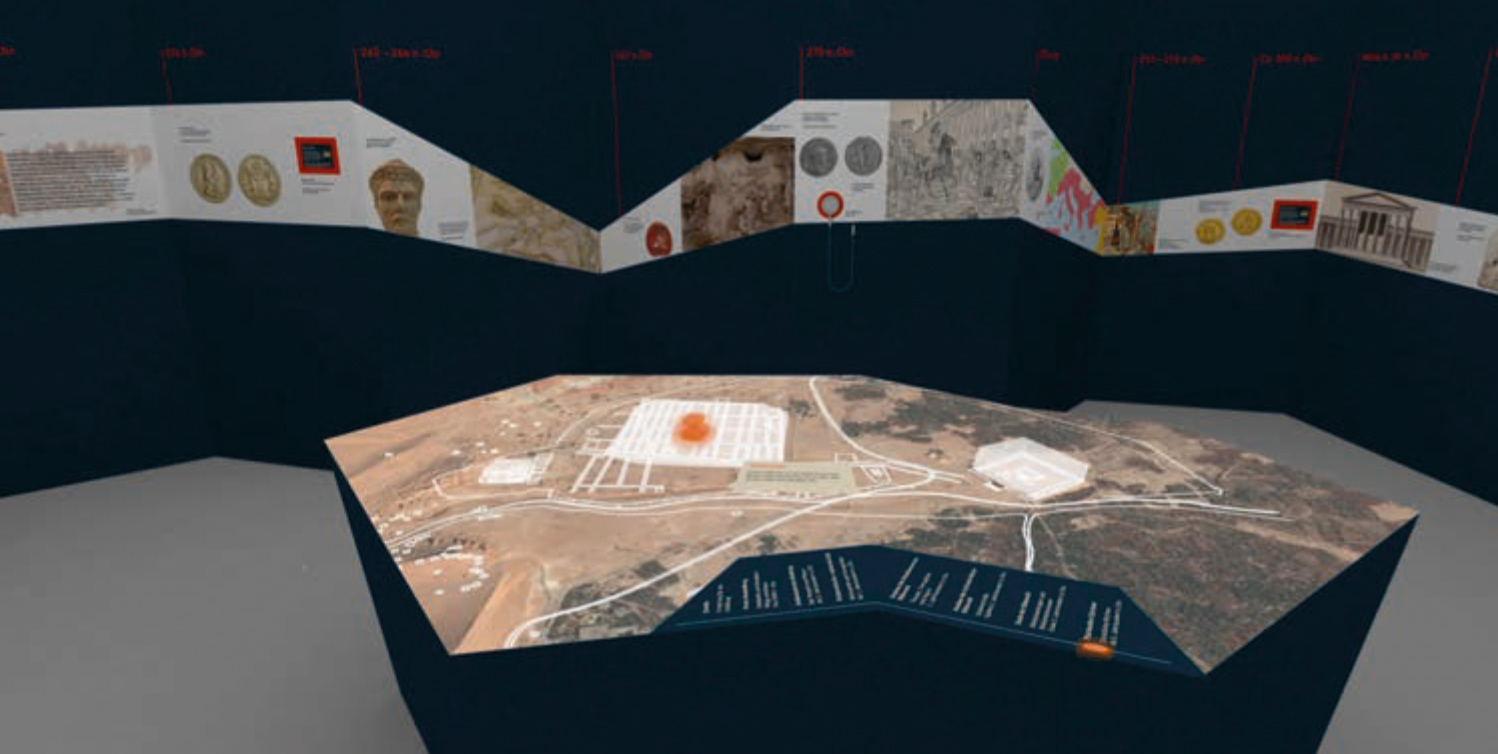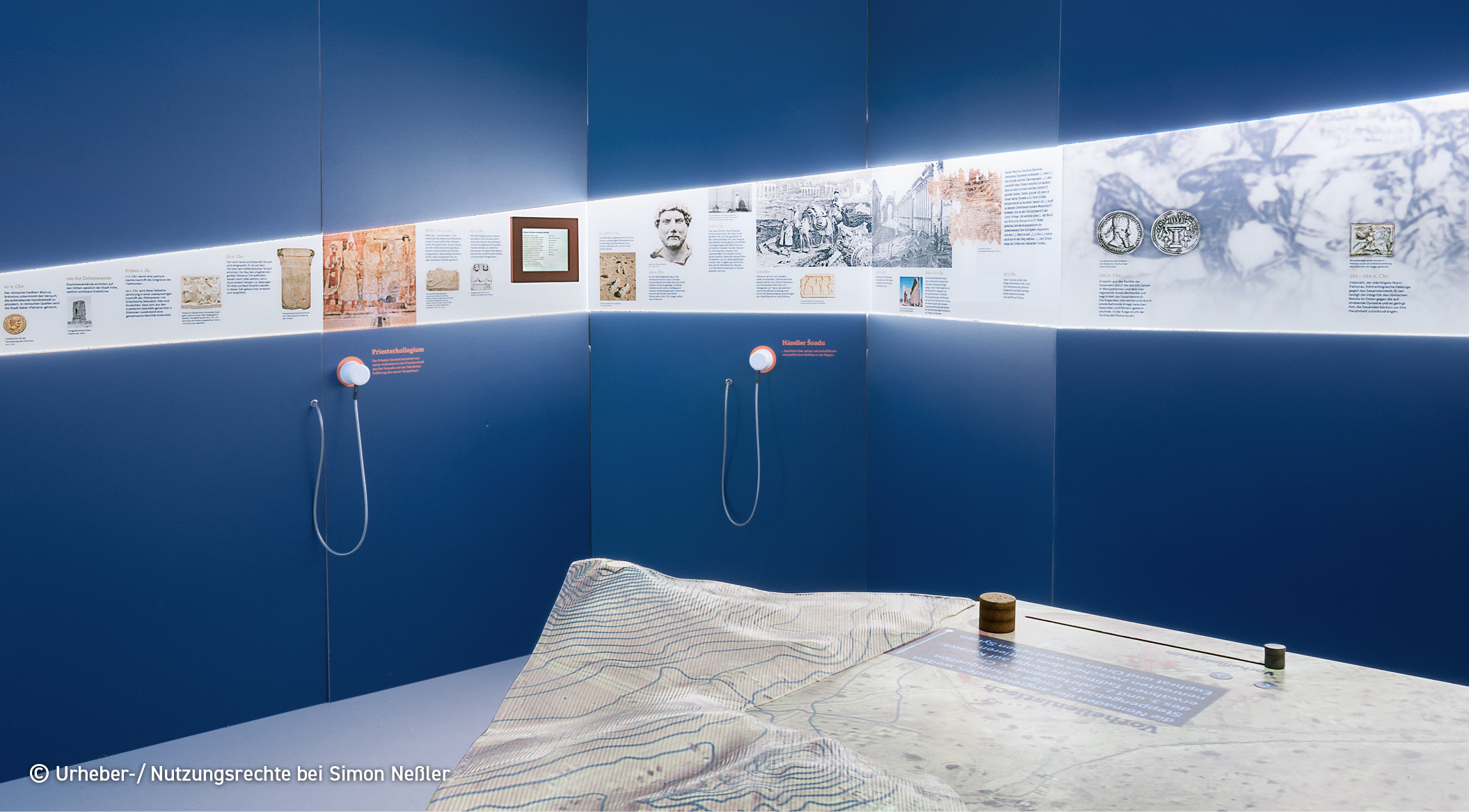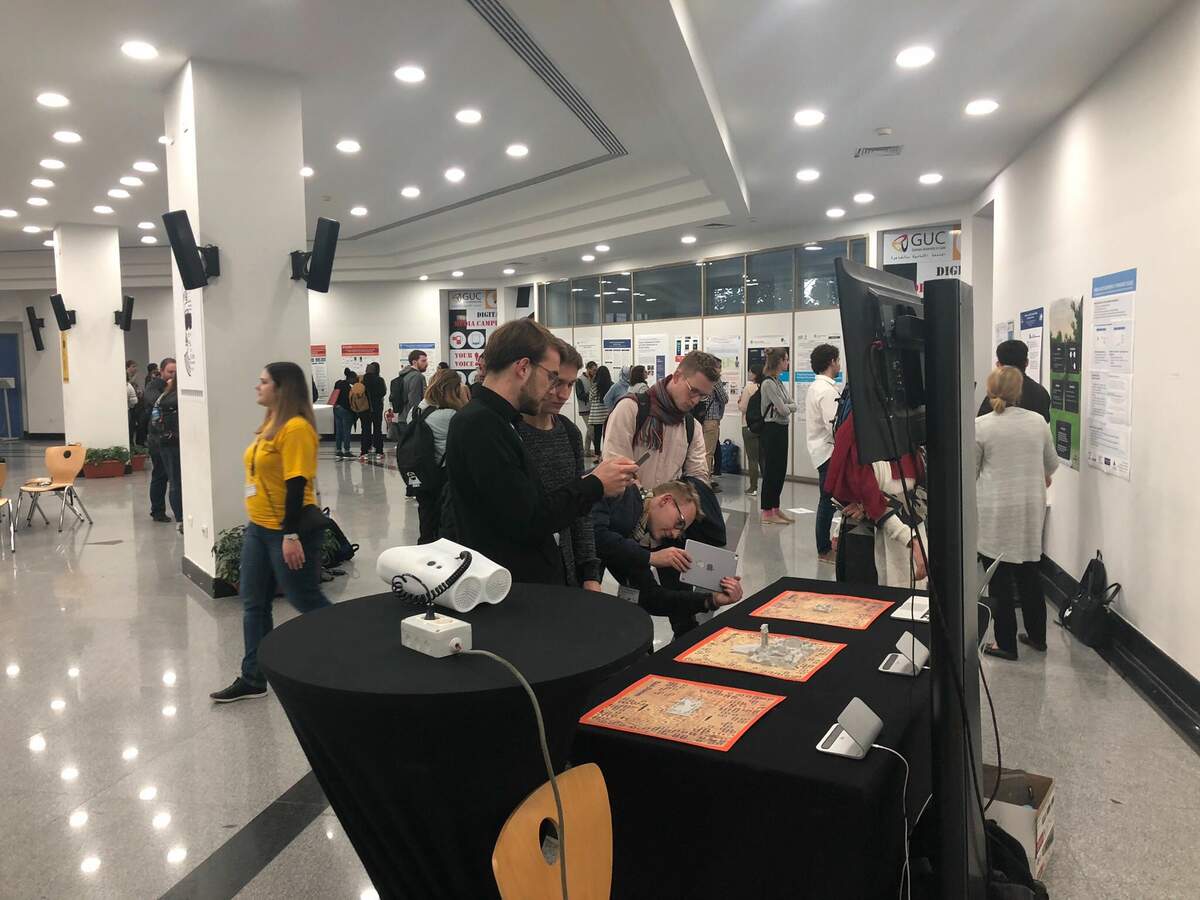Designing An Interactive Multi-Visitor Tabletop For An Exhibition
Client
- University of Konstanz
- HTWG Konstanz
Team
- 1 Communication Designer
- 1 Architect
Awards
- ADC Silver Nail 2018 (Junior Contest)
- Adobe Government Creativity Award 2018
Year
- 2017 – 2018
Tasks
- Design
- Implementation
- Evaluation
- Publication

Can we make Palmyra’s city development an interactive multi-visitor experience?
The interactive tabletop in the second room of the exhibition „Rebuild Palmyra? – Zukunft eines umkämpften Welterbes?“ (Future of a contested world heritage) lets visitors experience the development of the city of Palmyra over the course of centuries. The approximately 3x2m large exhibit is the focus of the room and immediately captures the visitor’s attention with its polygonal shape and three-dimensional surface, modeled after the elevation profile of Palmyra. The tabletop’s surface shows a map of Palmyra, on which additional content is augmented. By moving a slider, visitors can see how the city, which is displayed as outlined, changed over time. On the other side of the tabletop, visitors can switch between the most important buildings of Palmyra, which are then highlighted on the tabletop.
An overview of the interactive tabletop.
Results
We designed the exhibition „Rebuild Palmyra?“ in an interdisciplinary team of Architecture, Communication Design, Computer Science, and History students of the University of Konstanz and HTWG Konstanz. I was one of the computer science students and was responsible for the concept and design – together with one communication designer and one architect – and solely responsible for the development of the interactive tabletop.
It was a hugely rewarding project for me, not only because of its success but also because working in a talented team of different disciplines was a very enriching experience.
The Exhibition
„Rebuild Palmyra?“ was a multimedia exhibition about the city of Palmyra and the question of whether its ruins should be rebuilt. The exhibition helped visitors to understand the historical significance of Palmyra and the current discussions about the protection of world cultural heritage. Numerous interactive exhibits enabled the visitors to individually engage with the content with the help of novel technologies such as augmented and virtual reality.
The exhibition was a great success with visitors. The monthly number of visitors was doubled in comparison to the average of other exhibitions at the exhibition space (Turm zur Katz Konstanz). In the physical guest book of the exhibition, the visitors particularly emphasized the elaborate design of the exhibition and of the interactive installations. It was so well received that – despite it not being designed for it – the exhibition was commissioned to move to Braunschweig, where it was displayed a second time at the Braunschweigisches Landesmuseum.
The exhibition "Rebuild Palmyra?" was an interactive exhibition that tackled the question of "how do we deal with the destruction of cultural heritage?"
The interactive tabletop
The interactive media table was placed in the center of the exhibition’s second room. With its large size and eye-catching shape, it was this room’s highlight. The table’s surface was not flat but three-dimensional, modeled after the elevation profile of Palmyra. On this surface, a projector projected a map of Palmyra and its city’s outline. The visitors could control this projection using various input modalities such as a slider, buttons, and rotary knobs. I was part of the design team of the tabletop and solely developed the installation. For its development, I combined multiple components, such as projection mapping software, VJ software, and custom-made Processing Sketches.
The interactive tabletop featured a three-dimensional surface and various interaction possibilities.
Publications and Awards
The exhibition was also very well received by critics and won the Adobe Government Creativity Award in the category Interactive Design and a Silver Nail by the Art Directors Club Germany. At the same time, I was able to publish a full paper about the exhibition and a demo paper about our approach to exhibition design at national and international conferences. You can find the list of publications here.
”The work stands out for its professional research, depth of content and scenographic superiority. In particular, the cross-disciplinary collaboration is outstanding.
ADC (Art Directors Club)
Process
Together with an architecture and communication design student, I was responsible for the design of the interactive tabletop in room 2, which was supposed to be the room’s highlight. When I joined the team, the overall architectural and design concept was nearly finished. However, the interaction design was not.
Starting point
The rendering below shows some key differences to the final product. The table’s surface is flat and the map is printed on it. Buildings made from acrylic glass are placed on the surface. The plan was, that if a visitor touches a building, it lights up, and a projector projects additional information about it. Simultaneously, the slider was bent for aesthetic reasons. From a technical point of view, the slider was supposed to be implemented with the help of a mouse, mounted below the slider and whose x,y position was supposed to be readout. The building touch was supposed to be detected using some form of a capacitive sensor.
Feasibility Testing
The first thing I did was testing whether the installation could be implemented as planned. Keep in mind that this was a student project, where industry-grade custom solutions were not an option financially-wise.
I started with the acrylic glass buildings, as I saw this as the most problematic point. I had previous experience with capacitive sensors and knew, that they were very finicky and error-prone. I could not find any solution (e.g., light sensors) that provided the level of control we needed. So we could not be sure that the installation would react each time, a visitor touched a building. However, especially in exhibitions, which are public spaces, it is important that interactions work, because visitors get easily insecure and, finally, frustrated when things do not work as expected.
Similarly, we could not find any solution for designing the slider in that bent way, and, testing the sensitivity of the mouse, I noticed that we could not reliably read out the sensors if visitors moved it too fast.
Improvements and Synergy Effects
Consequently, we made a lot of changes. We moved the slider to the other side of the table, where there was no bent area. We switched from using a mouse to building a custom slider together with the university workshop. This way, I could read out exactly at which position the slider was.
When visitors move the slider, they travel through the city's development over the centuries.
And we decided to lose the acrylics buildings and instead project the building’s outlines onto the table’s surface (see video above). As is so often the case, one forced modification led to a range of new ideas, which ended up improving the initial one: As we now did not have any static elements on the surface and were projecting most of it, the question arose: „Why do we print the map on the surface? Can we not simply project the map on the table as well?“ With that question, the next idea came to mind: „Couldn’t we then sculpt the table after the elevation profile of Palmyra and use projection mapping to perfectly align the map to the surface?“
These effects happened several times during this phase and were only possible through the tight collaboration between the three different disciplines. In one case, the architecture student suggested using a VJ software called Resolume to prototype the visual feel of the animations. As I took a closer look at the software, I noticed that we could implement the whole installation with it!
The designer could pre-render all the animations, such as the expanding outlines or the lighting up of the buildings, in his preferred tool. I could then stack these animations in Resolume and make them interactive via Processing Sketches that captured the visitor’s interaction. Below you see example interactions in the installation, starting from a visitor moving the slider, to switching between buildings on both sides of the table.
The animations react when people either move the slider or press one of the two buttons on either side of the table.
Evaluating Rebuild Palmyra
Lastly, together with a group of fellow computer science students, I evaluated the exhibition’s interactive exhibits using visitor interviews, user experience questionnaires, and data logs of the exhibits. Our research was aimed at the novel technologies we used in the exhibition, so we only did the evaluation regarding the AR and VR devices. Then, I wrote up the results of the research in two research papers. These were published at EVA Berlin 2017 in Berlin and MUM Conference 2018 in Cairo. I presented the results at both conferences.
Used Tools
Hardware
Short-Distance Beamer, Phidgets, 2 Desktop PCs (hidden in the table), Bluetooth Buttons
Software
Resolume, MadMapper, Processing
Languages
Processing/Java
Publications
-
Skowronski, M., Wieland, J., Borowski, M., Fink, D., Gröschel, C, Klinkhammer, D. & Reiterer, H. (2018). Blended Museum: The Interactive Exhibition „Rebuild Palmyra?“. In Proceedings of the 17th International Conference on Mobile and Ubiquitous Multimedia (MUM 2018). Association for Computing Machinery, New York, NY, USA, 529–535. https://doi.org/10.1145/3282894.3289746
- Skowronski, M., Wieland, J., Borowski, M., Fink, D., Gröschel, C, Klinkhammer, D. & Reiterer, H. (2017). Rebuild Palmyra? : Zukunft eines umkämpften Welterbes. In Konferenzband EVA Berlin 2017 : Elektronische Medien & Kunst, Kultur und Historie. Staatliche Museen zu Berlin, Berlin, 70-80. ISBN 978-3-88609-801-9
